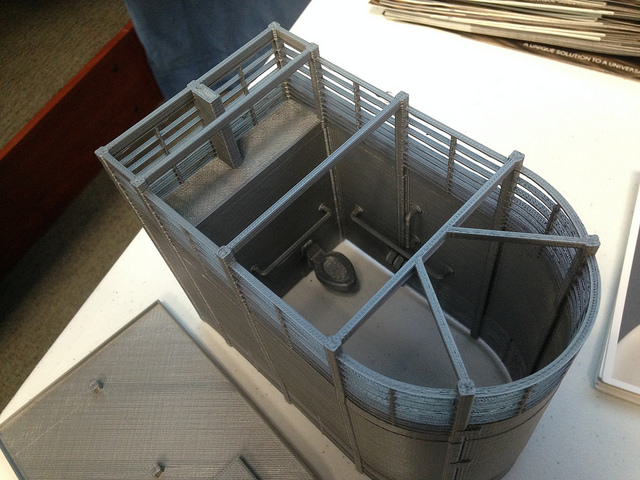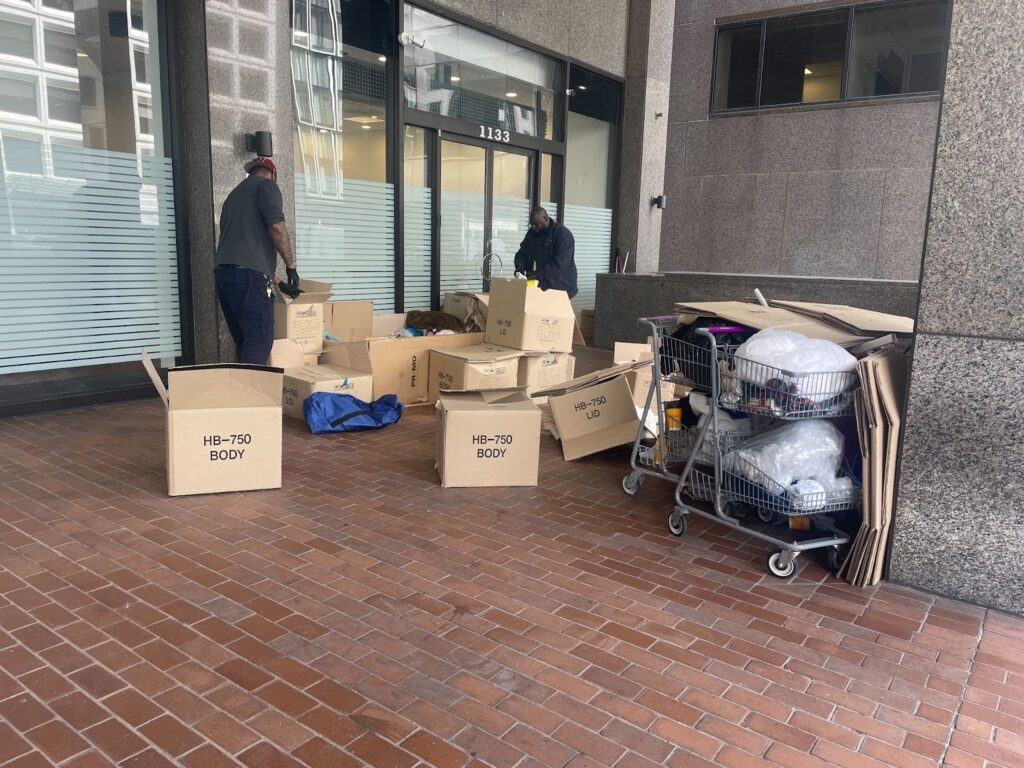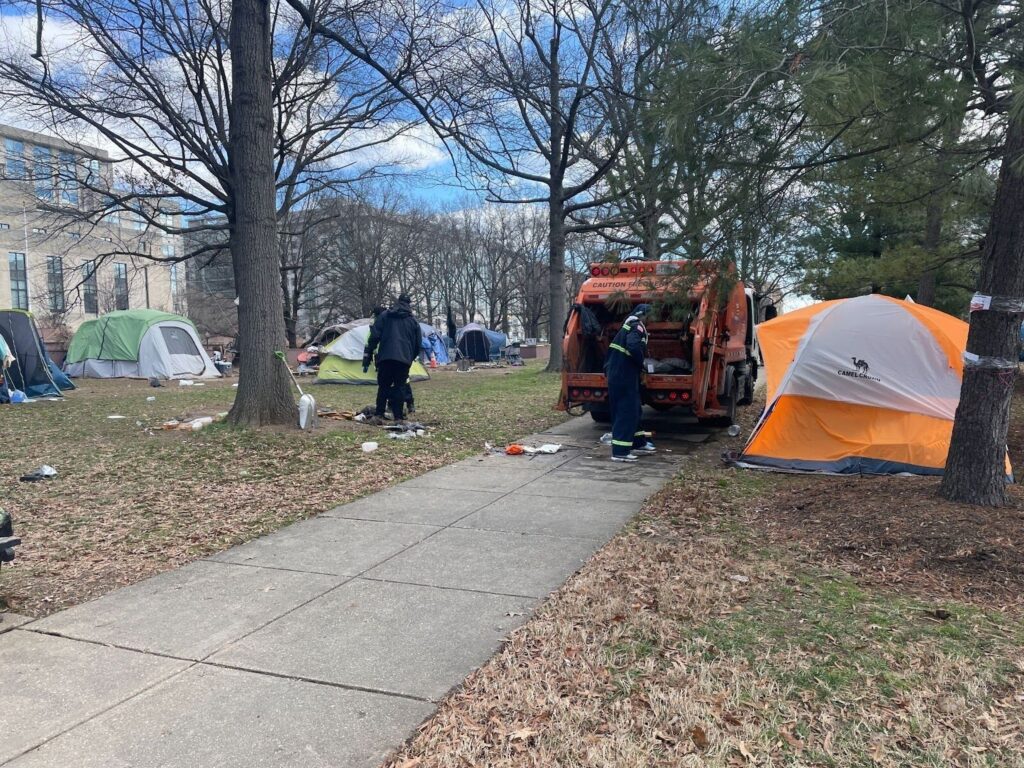Dirty. Creepy. Hard to find when you need them.
That’s how Jennifer McLaughlin describes some of the public bathrooms she’s used over the years. McLaughlin, a member of the People For Fairness Coalition (PFFC), sits with a small band of advocates in a public cafeteria each week, discussing accomplishments and steps needed to see more clean, safe and available public toilets installed across the city.
“I used to be on the street, and I had a son,” she recalled. “It was hard to find places that would actually let me go and use the bathroom, or change him.”
Many people experiencing homelessness must rely on the generosity of business operators for use of a toilet, or come up with the money to purchase something to justify use of facilities labeled “for customers only.”
McLaughlin believes homeless folks are not the only ones in need of public toilets. For example, she notices that many people get their lunch from food trucks these days, which cannot offer restrooms for their customers like traditional brick and mortar establishments.
PFFC adopted the public toilet cause after Street Sense vendor Gary Minter brought the issue to the table at the group’s routine “call for concerns.” A four-person leadership team has been formed to head a committee to tackle the problem. The group is still looking to enlist a couple more individuals passionate about the topic of public bathrooms.
“Mine is more a women’s issue,” Janet Sharp–another committee leader–explained. “Pregnant women, homeless women during their menstrual cycle, people farther up in age–like me–when your bladder doesn’t hold like it used to, tourists…”
Destination DC, a nonprofit leading marketing Washington as a tourist destination, believes most tourists’ needs are met during the day by the facilities in the museums and around the monuments on the National Mall.
Media Relations Manager Kate Gibbs understands that some tourists may have special needs – such as families with young children. She said the group believes in “championing whatever infrastructure can help visitors find Washington and spend an enjoyable holiday here.”
Destination DC, like PFFC, believes any public toilets provided for the city would have to be exceptionally clean, in constant working order and safe.
Sharp worries about the health risks of “holding it in,” which her doctor has warned against.
Indeed, Johns Hopkins Medicine reports that if urine stays in the bladder too long, pressure may build up and lead to infection or damage of the bladder or kidneys. Holding in urine too often may also reduce the body’s ability to determine when a person has to “go.” Holding in feces similarly disorients the body’s sense of when the colon needs relief, and may lead to constipation.
“I would not want to hear that someone died because they had to hold it in – kidney failure or anything else,” Sharp said.
PFFC launched a feasibility study late last year to determine the project’s practicality. That’s when they discovered the Portland Loo, individual private toilets located in public areas throughout downtown Portland, Oregon.
The first Portland Loo was installed December 2008 after a community campaign of more than three years.
“The Old Town/Chinatown Neighborhood Association had been working on this for years and not gotten anywhere,” said Carol McCreary, then-Portland resident and co-founder of Public Hygiene Lets Us Stay Human (PHLUSH).
McCreary believes her community was lucky to get the right people in the room together in 2006: representatives from the mayor’s office and the parks bureau, and candidates for some local offices participated in the community campaign. At that time, Portland’s mayor, Tom Potter, requested activists develop a design of renovated and new bathroom units. Urban and Public Affairs students from the local university drafted a policy recommendation for the project, which Potter and City Commissioner Randy Leonard put into action.
“We succeeded, now there are restrooms every eight blocks, open 24/7; and these are short blocks: Portland blocks are 200ft,” McCreary said.
When PHLUSH began shopping the idea around, an early design was to construct the unit from plastic material resembling playground equipment, for reasons of affordability. However, an architect recommended that it be upscaled for city streets. The resulting product, made entirely from stainless steel, goes for $90,000.
The City of Portland entered into a manufacturing agreement with Portland-based Madden Fabrication, with a plan to sell the copyrighted design directly; however, the Loo business didn’t work well as a public entity, and Madden Fabrication ended up taking ownership mid-2014, maintaining a royalty agreement with city government.
There are seven Loo modules in Portland. The first to be installed out-of-state went to Victoria, British Columbia in 2011 It was voted “Canada’s Best Restroom” the very next year. Installation has since been completed in California, Alaska and other parts of British Columbia. Seattle, Cambridge, Salt Lake City, and Cincinnati already have their own on order.
“I’d love to see it just become a standard. It really solves a lot of problems with cities not having bathrooms. It makes the city more walkable,” said Greg Madden, president of Madden Fabrication.
McCreary takes pride in the fact that the first Loo, installed in 2008, is in nearly-new condition six years later. The stainless steel is very hard to dent and the surface is treated with anti-graffiti coating. Each Loo has a locked interior cabinet containing a hose that maintenance workers use to spray down the facility as needed; this design element was influenced by then-City Commissioner Leonard’s experience as a fireman.
“Our champions in city hall deserve the credit (Potter and Leonard),” McCreary said. “The local water bureau that takes care of our fountains was able to put resources toward the project. Department of Transportation was also very helpful in placing the Loos…”
PHLUSH will take credit for the efficiency of the design. The handwashing station is located on the outside of the facility, allowing one person to use the toilet while another washes their hands or fills a water bottle. This is beneficial not only in case there is a line to use the facility, but also because it makes handwashing available without entering the unit.
The Centers for Disease Control equates handwashing to a “do-it-yourself vaccine you can take to reduce the spread of diarrheal and respiratory illness” to avoid the spread of germs to you or others. This is especially important for area homeless people, who are three times more vulnerable to infection than their housed neighbors.
Sanitation, which is vital for community health, was recognized by the United Nations (UN) General Assembly as a human right in 2010. The UN calls upon nation states and international organizations to help provide safe, clean, accessible and affordable drinking water and sanitation for all. Three years later the UN officially recognized November 19th as World Toilet Day, an advocacy and action day observed by a variety of other organizations since 2001. According to UNwater.org, lacking a secure place to defecate openly infringes on human safety and dignity.
“People should have the right to pee for free with dignity,” Michael Stoops, Director of Community Organizing at the National Coalition for the Homeless, said.
The Portland Loo is designed to meet Americans with Disabilities Act (ADA) guidelines for accessibility so as not to exclude anyone. District cyclists may be happy to learn that a full-size bicycle can fit easily within, so there is no need to find somewhere to lock up the bicycle before using the loo. Despite the space and open access, Portland has not had problems with individuals seeking shelter in the stalls for extended periods of time.
“It’s really an urban bathroom,” Madden reflected. “It’s just a toilet. You go in there and there’s nothing to do but use the toilet. And people can see your feet and know you’re in there. With the ambient noise, you don’t want to be in there very long.”
Madden Fabrication continues to tweak the design as suggestions come in from customers, but the Loo has remained mostly unchanged for the past six years.
PFFC’s third concern, next to accessibility and cleanliness, is safety. The Portland Loo is designed with bars and louvres at the top and bottom of the otherwise solid walls, so that anyone approaching can see if the unit is occupied. For nighttime use, the module is well lit on the outside. The outer lights dim and inner lights engage when someone enters. These features can be powered by a solar panel, AC power hookup to the city’s grid, or solar with AC backup.
As they complete their assessment of the need and opportunity for DC Loos, PFFC also looks for support in the community.

“The Portland Business Improvement Alliance was an incredible ally in getting restrooms for all,” McCreary said.“ One thing the Alliance’s Clean & Safe program has to do every morning is scoop poop.”
Clean & Safe is also paid by the city to clean six of Portland’s seven Loos. Project Manager Jay McIntyre, who has been overseeing this process for over 3 ½ years, said to his knowledge, and certainly, since he became Project Manager, there have been no safety issues with individuals who use the Loos.
Before putting in their own Loo, Victoria, British Columbia noticed that after city bars would close at two in the morning, evening revelers would have nowhere else to go, and many relieved themselves in alleys or doorways.
“The irony is, in the 30’s and 40’s bars were where you turned to for public bathrooms,” Madden pointed out.
In Portland, McIntyre has also observed that in areas where Loos are used at night, there is a significantly lower need to scoop poop.
The Washington DC Downtown Business Improvement District (BID) has received no direct requests for additional public bathrooms in the downtown area to date.
PFFC believes their Loo campaign is unique because while they want the facilities installed in beneficial locations for everyone, no other city has begun the process by deliberately considering where many homeless people may be in need of facilities.
Based on other cities’ experience with the Loo, PFFC envisions working alongside downtown businesses, ANCs, city council members, the DC chapter of Americans for Disabilities, organizations that support the homeless and others near proposed Loo locations.
PFFC is using a heat map generated by Downtown BID to supplement their own knowledge and find out where homeless people spend the most time during the day and night, respectively. Within those locations, they will identify areas most heavily trafficked by pedestrians to suggest sites for Loo installation.
“We have to go out and find out which area bathrooms are discriminating against the homeless and which ones ain’t,” said John McDermont, another PFFC committee leader for the Loo. “Which bathrooms are open to the public, and which one’s ain’t.”
The group started by developing a checklist to audit existing bathrooms in areas of Downtown DC. The checklist looks at whether there is free entry or a lock making the bathrooms only available to customers; the cleanliness of the restrooms; what and how many hours it is open; and whether there are safety considerations.
McDermont understands that businesses are worried about people who “tear up” the bathrooms, and its not just people experiencing homelessness. However, he claims to have seen homeless folk asked to leave even when they enter an establishment to make a purchase, under the assumption they’re seeking the bathroom.
“Homeless people should not be treated as third-class citizens,” McDermont said. “They should be treated like human beings and their need to use the bathroom respected.”
Plans for the redevelopment of D.C.’s Franklin Square are moving forward (the public comment period for its environmental assessment having closed on January 9) and include the addition of public bathrooms in the park. But PFFC worries the bathrooms will not be open 24/7; McDermont is also concerned that homeless people who currently frequent the park will be displaced during construction.
The National Park Service does not expect that the entire park will be closed at any time during construction. In the long run, park officials say an important goal of this project is to encourage all visitors to enjoy and use the park. Downtown BID anticipates the public bathrooms for Franklin Park to only be open when the on-site café is in operation.
Janet Sharp argues that more public toilets with 24/7 access will go a long way to that end, saying that people won’t use the park now because the trees smell like piss.
“We just got a new mayor, we just got a bunch of new city councilmen, we’ve got to locate where we think Loos could be placed, and we’ve got to get feedback,” McDermont said. “ If we don’t have our ducks in a row, we waste our time going to City Hall.”
PFFC Director Robert Warren hopes to raise enough money to send a few members to see the Portland Loos firsthand.
“We want businesses to support us because business owners are going to close their business, and their restrooms, some time for the night,” Warren said. “We’ll have to look out though if we do get Portland Loos put in, and make sure businesses don’t start to make their own restrooms less available.”
The PFFC committee hopes this campaign will take less time to get off the ground than Portland’s did, but anticipates one to two years of work ahead. They see the lack of public toilets in the nation’s capital as an embarrassment.
“We want to show just how this can benefit the downtown community and all the folks that frequent downtown,” Warren said, “but that’s where homeless people be – and they’re going to have to use the bathroom.”
Josue De Paz and Laetitia Vidor contributed to this report.









